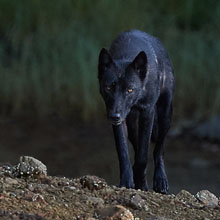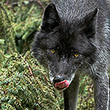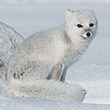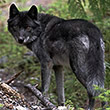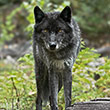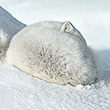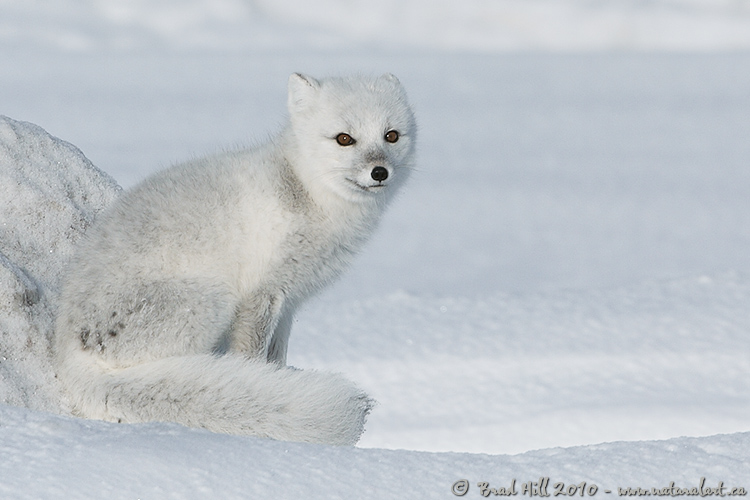
Availability: Undetermined - Enquiries?
In the Field
One Arctic Fox - Chilled on Ice? Cape Churchill, MB, Canada. October 25, 2004 (image re-processed in early 2010).
Arctic Foxes are beautiful, small carnivores with luxuriant coats. They inhabit an environment that for over half of the year is darned cold (to say the least). Imagine living in a sub-zero world where daily highs of -20C are balmy! Do the foxes get cold (or notice the cold)? Who knows! But when I snapped this shot the one thing going through my mind was "Man...that fox sure looks like he's cold!".
Photographically the biggest challenges with this shot were getting the exposure right and then extracting the beautiful white-on-white detail during processing. While I find Nikon's Matrix metering system exceptionally effective, there are instances where it doesn't get it quite right. When photographing a bright white object on a bright white background you have to over-ride the metering system and overexpose the scene (otherwise the bright whites come out as dull grays!). In this case I over-rode the metering system by 2/3 of an f-stop (over-exposure).
In terms of image processing: I first processed this image back in 2004 using a much earlier version of Phase One's Capture One Pro raw conversion software. I re-processed it early in 2010 using their most current software at the time (version 5.0.2). As expected, the newer versions of the software did a much better job at converting the raw file, and produced a much sharper image with better separation of the subtle white-on-white details. It's nice to know that the ongoing software investments do more than keep one compatible with the RAW file formats of the newer cameras!
Behind the Camera
One Arctic Fox - Chilled on Ice? Cape Churchill, MB, Canada. October 25, 2004 (image re-processed in early 2010).
Digital Capture; Compressed RAW (NEF) format; ISO 200.
Nikon D2H with Nikon 200-400 mm f/4G ED-IF AF-S VR lens @ 400 mm (600 mm EFL) supported on bean bag. VR turned to "On" and in "Normal" mode.
1/640s @ f7.1; +0.7 stop exposure compensation from matrix-metered exposure setting.
At the Computer
One Arctic Fox - Chilled on Ice? Cape Churchill, MB, Canada. October 25, 2004 (image re-processed in early 2010).
RAW Conversion, including first-pass sharpening, using Phase One's C1 Pro 5.0.2. Two raw conversions at different exposure settings to balance final exposure. Raw conversions at -0.67 stops (to reduce brightness of sunlit snow in background) and +0.25 stops (to retrieve shadow detail on portions of the fox).
All further digital correction on 16-bit TIFF file using Adobe's Photoshop CS4 and Light Craft's LightZone 3.8.5. Photoshop adjustments included compositing (layer and masking) of 2 exposure variants, selective colour saturation and desaturation, and selective sharpening for web output. Final tone tweaking and adjustments using the Tonemapper/Re-light tool of LightZone.
Conservation
One Arctic Fox - Chilled on Ice? Cape Churchill, MB, Canada. October 25, 2004 (image re-processed in early 2010).
Ten percent of the revenue generated by this image will be donated to the Yellowstone to Yukon Conservation Initiative.
Species Status in Canada*: Not "Endangered" or "Threatened".
In Canada the Arctic Fox (Alopex lagopus) is not listed as an endangered species and, as such, is not afforded any legal protection (it is still considered a relatively important commercial species in Canada, although low fur prices in recent years have reduced the occurrence of hunting of this species). Recent documented northward expansion of the range of the Red Fox (which is a primary predator of the Arctic Fox) may prove to be threat to Canada's Arctic Foxes in the future. It is possible this is an indirect consequence of global warming.
The Arctic Fox is threatened with extinction in Sweden, Finland, and mainland Norway. As such, both the foxes and their dens have been legally protected for decades (since 1928 in Sweden, 1930 in Norway, and Finland since 1940).
The Yellowstone to Yukon (Y2Y) Conservation Initiative seeks to ensure that the world-renowned wilderness, wildlife, native plants, and natural processes of the Yellowstone to Yukon region continue to function as an interconnected web of life, capable of supporting all of its natural and human communities, for current and future generations.
*as determined by COSEWIC: The Committee on the Status of Endangered Wildlife in Canada


















